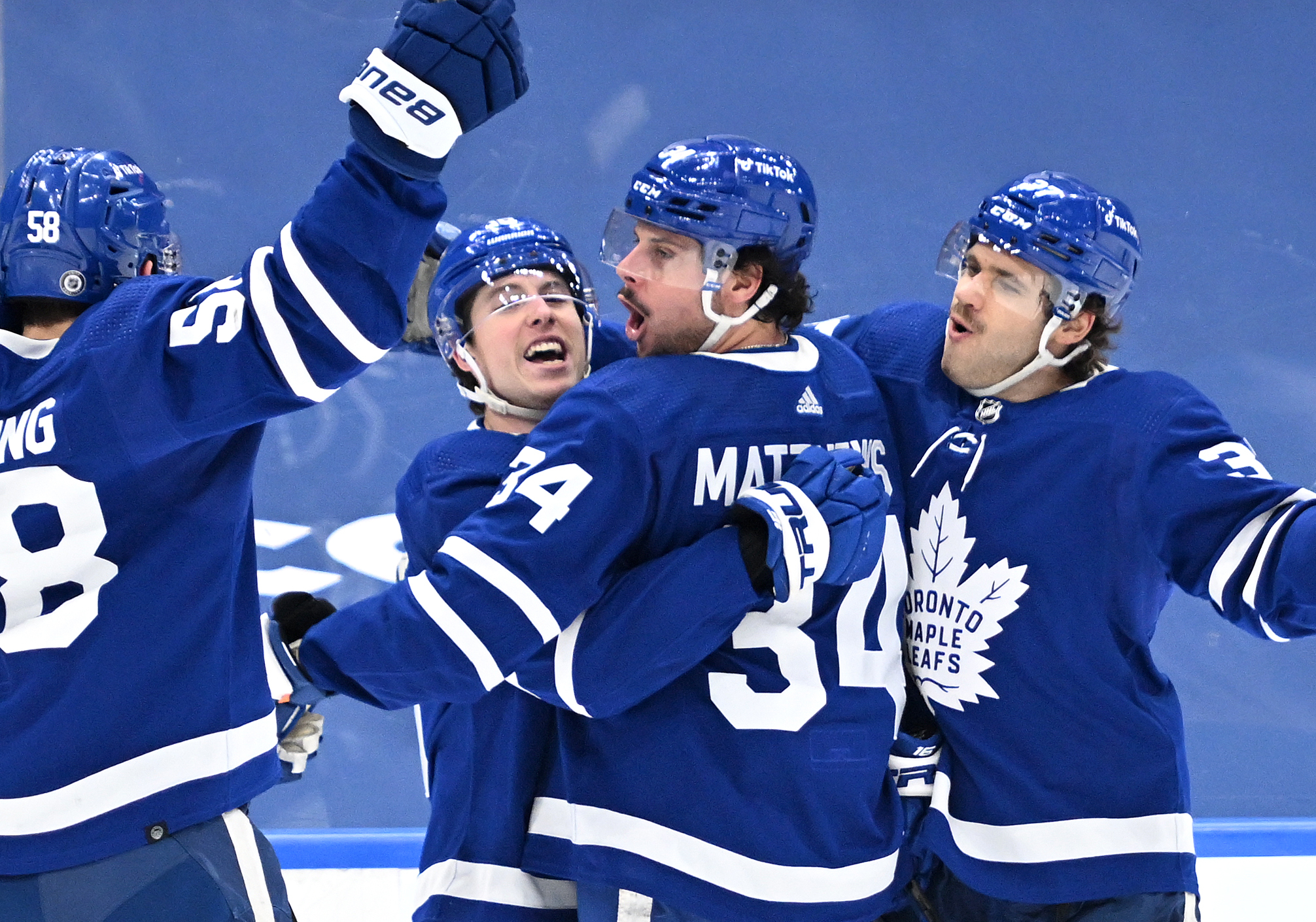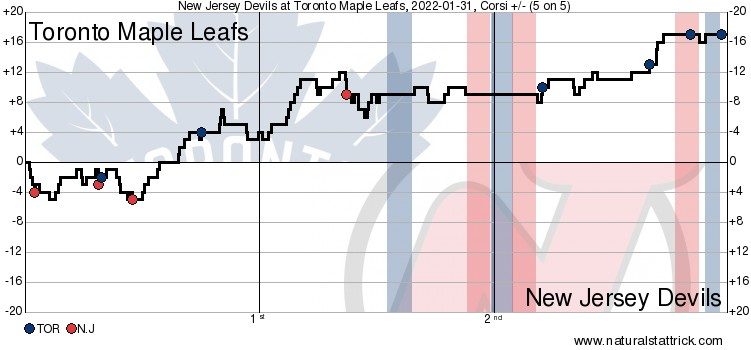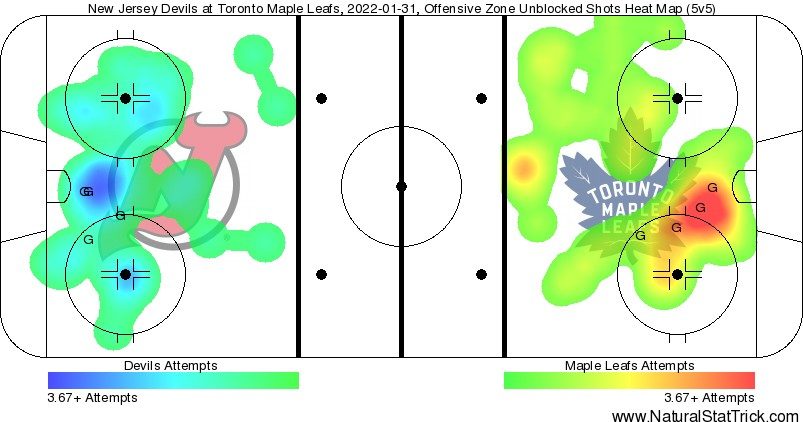After a thrilling comeback win against the Detroit Red Wings on Saturday night, Sheldon Keefe decided to stick with the lines that earned the victory, noting that it was his “optimal” lineup.
Regardless of the result in this one, I thought it was disappointing to see him abandon the experiment after basically 1.5 games. We know this team is going to make the playoffs, where they are going to play an elite team in the first round no matter what happens for the rest of the regular season. These types of games present opportunities to play around with the lineup and try out different combinations, collect some data, and better understand how to move the pieces around should anything unforeseen transpire in the playoffs (with this franchise, it usually does).
It’s fine to believe these are the optimal line combos, but if we’re honest, the Leafs haven’t tried out all that many while fully healthy in order to come to such a conclusion unequivocally (it may well prove to be the best configuration, but I’d argue we don’t know that yet).
This game against New Jersey on Monday featured another slow start that resulted in a regulation win. Credit to the Leafs for pulling it off, but this was by no means pretty.
Oh, and no fans in the building really sucks.
Your game in 10:
1. Somewhat similar to the Detroit game, the New Jersey Devils came out flying and took it to the Leafs from the very shift of this game. Sheldon Keefe opted to start the top line for the game, which was likely a fair nod to how good they were in the Detroit game. They didn’t get the puck deep after getting outplayed on the shift, which led to a hasty line change where the Leafs were lost in coverage and the Devils promptly took a 1-0 lead early in the game.
Prior to shaking up the lines, the unit that Keefe was running out to start games was the David Kampf trio with Ilya Mikheyev and Pierre Engvall. They did a good job of most often winning the faceoff, getting the puck below the goal line, and establishing a forecheck and cycle. I was wondering if Keefe would switch it up to start the second period, but he did not – Matthews actually won the faceoff, Rielly turned it over, the Devils put a shot on net that led to a defensive zone faceoff 18 seconds in. Keefe kept the top line out for that faceoff as well, and they moved the puck up ice for some offensive zone time before the Devils iced the puck.
2. After the Detroit game, Keefe mentioned that he did not like how his team cleared the front of their net. Well, the second Devils goal saw Justin Holl fail to clear the net off a shot that was clearly intended to create a rebound. The fourth line was on for that goal against.
3. To the Leafs’ credit, they responded to the second goal by scoring 13 seconds later. Michael Bunting and Mitch Marner did well to get in on the forecheck and Timothy Liljegren pinched down the wall, leading to the puck coming loose to Matthews in the slot, where he fired it home as we would expect from one of the best goal scorers in the game.
Matthews doing Matthews things 🚀#LeafsForever pic.twitter.com/7gz0xJ8D90
— Toronto Maple Leafs (@MapleLeafs) February 1, 2022
Afterward, it felt like the game might settle down and the Leafs would start taking care of business, but that was not the case. The fourth line was on for their second goal against of the game, although it wasn’t really their fault. They won the offensive-zone faceoff, Liljegren got burned off the rush, and old friend Andreas Johnsson scored on a bad angle with Jack Campbell caught deep in his net.
4. In today’s Leafs Notebook, we noted how January was Campbell’s worst month of the season by far. As much as you’d like to give him the opportunity to work through struggles, the goals against were not great ones — especially the third NJ tally — and I thought pulling him was completely fair and justified. Keefe also did well to use the goalie switch as a fake timeout of sorts to settle the team down.
In November, when Campbell was scorching hot, I wrote that I’d let the season play out before signing him. This is pretty much exactly why; he’s coming down to earth. Is he still a good-to-maybe-very-good goalie? It’s quite possible, but he’s never played a full season before. The Leafs are wise to let the situation play out before making any sort of long-term commitment to a 29-year-old goalie that has never played a full season in the league.
5. After the 3-1 lead and the timeout, the Leafs’ third line generated a really good shift where they hemmed the Devils in their zone for an extended spell. A few shifts later, the fourth line did the same thing. It settled the game down a bit and started tilting the ice in the Leafs’ direction, even if they weren’t scoring.
Eventually, Matthews scored his second of the night. Prior to that goal, Bunting did really well to come up with the puck that led to a clean breakout (and what a nifty touch by Marner to Matthews to lead the neutral-zone transition). Rielly joined the rush nicely to put a shot on net that Matthews tipped in; Rielly is at his best in transition on those plays where he can act as the fourth forward.
TWO FOR TONE! 🚨#LeafsForever pic.twitter.com/yw86x1G7uC
— Toronto Maple Leafs (@MapleLeafs) February 1, 2022
6. I thought the Leafs came out in the second and generally controlled the play, but they weren’t doing enough to create grade-A scoring chances. As a result, they weren’t able to tie the game.
As is often the case in this sport, when one team controls play but isn’t converting, the other goes the other way and scores. It was a bit of an unlucky bounce for Petr Mrazek — the puck hit Rielly in front of the net and dropped perfectly for Nathan Bastian.
Mrazek did well to come in cold and keep the Leafs within striking distance, including a big save while penalty killing with a few minutes left in the second period. All you can ask of a goalie in this situation is to give his team a chance to come back. I thought Mrazek did that tonight.
7. The Leafs went to a power play in the second period to try to pull it within one, but the PP generated very little. Keefe was reasonably quick to pull the trigger on the top unit and put out the second, and they were a poke check by a diving defender away from creating the best chance on the power play.
The Leafs’ power play has been great lately and is ranked number one in the league, so any complaints feel nitpicky. You’d still hope for the top unit to create something of note while down two against a young goalie that really didn’t look confident. It was a good opportunity to get back into the game.
The Leafs went to another power play to start the third period and again created nothing; they actually ended it by taking a penalty themselves.
8. After the run of penalties, a trio of Mikheyev – Spezza – Kerfoot ended up on the ice, got in on the forecheck, created a turnover, and Mikheyev did really well to show some patience as he rounded the net and put it right on Spezza’s tape. Mikheyev’s goal scoring has predictably slowed down, but in previous seasons, we’ve seen him blindly throw it in front and hope for something good to happen in those situations. On this play, he took his time to make the right play. Spezza buried it with a beautiful shot.
VINTAGE SNIPE!!#LeafsForever pic.twitter.com/eefI6cdRYr
— Toronto Maple Leafs (@MapleLeafs) February 1, 2022
9. As the third period progressed, there was very little happening in the game. The Leafs were barely making a push halfway through the period, but with time ticking down, off of an offensive zone faceoff, the top line won a scrum and Marner buried it to extend his scoring streak to six games.
Touch of magic! 🎩#LeafsForever pic.twitter.com/65s0yVFBtM
— Toronto Maple Leafs (@MapleLeafs) February 1, 2022
Marner has looked great since returning, quieting some of the chatter about his game and place in the lineup. He’s an elite winger who is playing like it right now.
Shortly after tying the game, Matthews broke in and beat a defenseman clean off the rush but couldn’t convert (Bunting was stopped on the rebound, too). All told, it was three goals for this line in this game after they carried the Leafs to the comeback against the Red Wings. They’re a great trio. The questions really reside with the rest of the lines.
10. In what is becoming typical Leafs fashion (apparently), they completed the comeback in regulation — this time on the back of a shorthanded goal. I want to give Alex Kerfoot credit for freezing the defender and completing a nice pass, but it’s hard to ignore how poorly it was defended. All Kerfoot can do is take what’s given to him, and he did just that — kudos to him and Mikheyev for connecting — but it was just about the worst 2v1 defending you’ll ever see from an NHL defenseman (Damon Severson).
The patience on Kerfy!!#LeafsForever pic.twitter.com/xNRk9z201O
— Toronto Maple Leafs (@MapleLeafs) February 1, 2022
The Leafs ended the game with a win and Matthews completed the hat trick on the empty netter, but these slow starts have to be ironed out. Whether it’s the early leads that have been coughed up or coming back from multiple goals down in multiple games this month, the Leafs aren’t stringing together 60-minute games right now. It’s something that I’m sure the coaching staff will be working to address.
Game Flow: 5v5 Shot Attempts
Heat Map: 5v5 Shot Attempts
Game Highlights: Leafs 6 vs. Devils 4




































